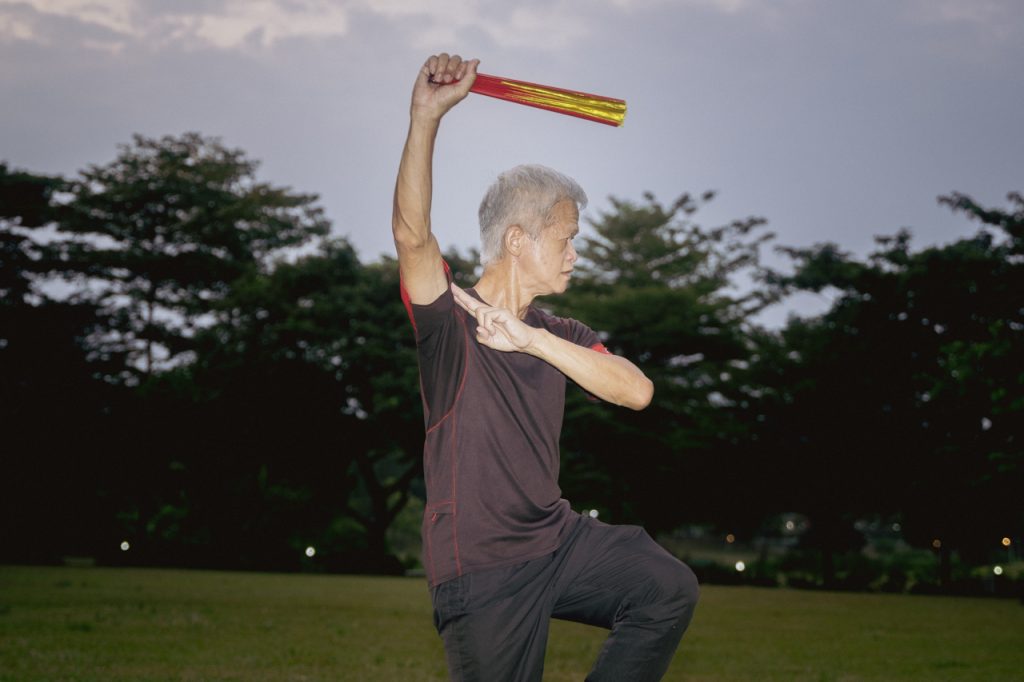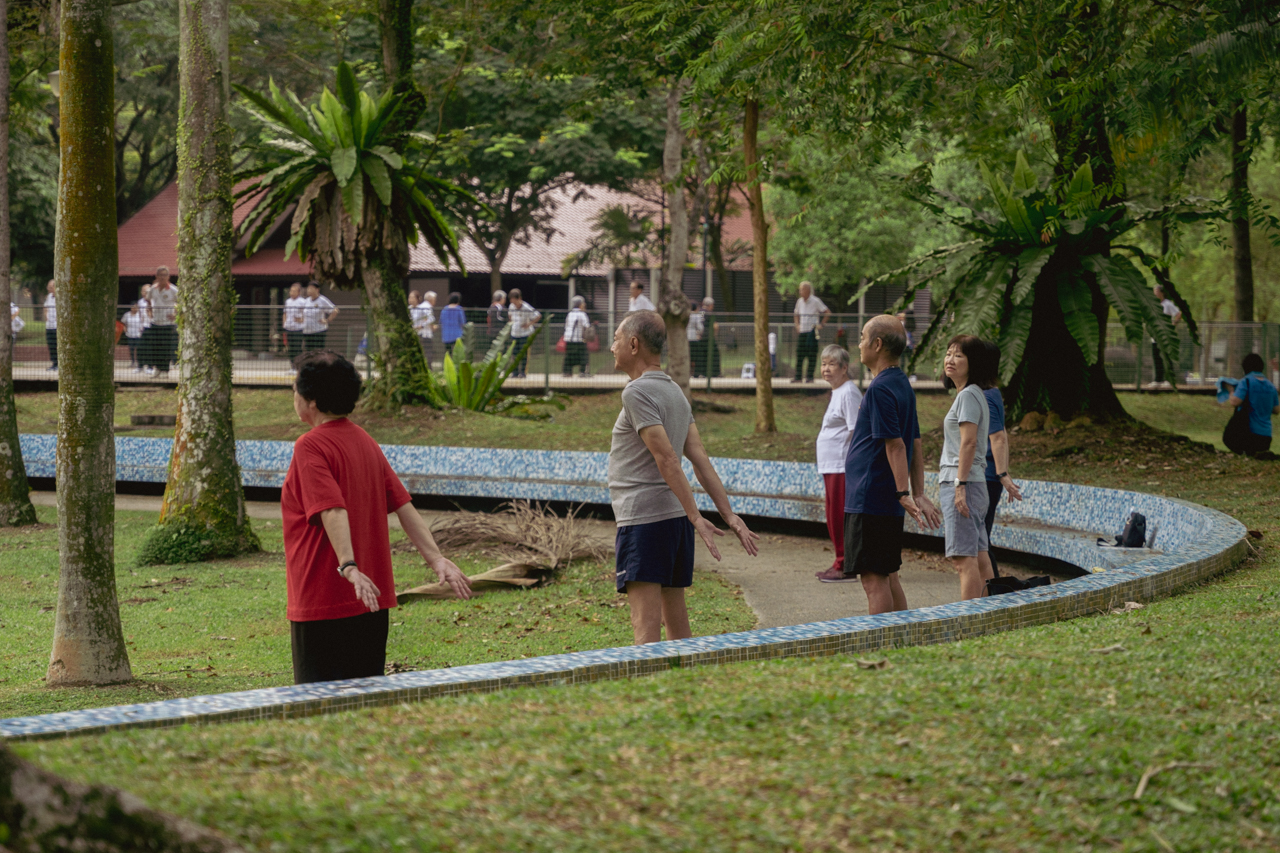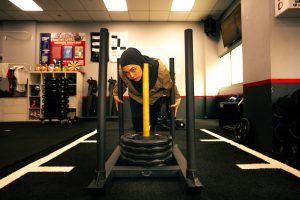All images by Marc Clarence Beraquit for RICE Media
It’s 7 AM at Bishan-Ang Mo Kio Park. The sun has barely risen, but I feel like I’m already late to the party.
The warm glow of McDonald’s Bishan Park outlet beckons. But just beyond it is the real reason I’m here: the morning people. Most of them have decades on me, but they’ve also got heaps more energy at this (relatively) ungodly hour.
I look out at the sprawling park with sleepy eyes. Nearly every open field and flat court-like surface in Bishan Park has been taken over by groups of elderly people. The morning sun hasn’t quite dissipated the chill of the night air yet, but most of the exercise groups are already in full swing.
The different factions are each focusing on doing their own thing. Some are practising qigong, moving through different poses at a glacial pace. Others are performing movements I can’t place: clapping their hands, smacking their own arms, and pulling on their ears.

Most of us probably chalk these curious morning exercise rituals up to old people being quirky. Like how my mum likes to leave onions in my room to protect me from viruses. Or how some uncles like to walk around with their shirts rolled up, baring their bellies.
But why do they all do the same weird movements? Where are they learning this? Do Singaporeans just start smacking their bodies at the crack of dawn the moment they’re eligible for Senior Citizen Concession Cards?
I know I’m not the only curious one. Others who’ve spotted similar ‘rituals’ in their neighbourhoods have been weirded out. Instead of taking video clips and sending them to Stomp, I have a better solution: Asking the old folks exactly what they’re doing.
That’s how I ended up standing half-asleep in the middle of Bishan Park, with my colleague Marc in tow. He’s here to photograph whoever will let us photograph them. We hone in on a band of senior folks spread out over the banks of Kallang River.
The Dance of the Elderly Singaporean
The elderly folks are organised in neat rows and simply follow whatever the front rows are doing. There’s the aforementioned ear pulling, as well as very enthusiastic slapping of their elbows and knees.
A portable speaker blares what sounds like generic Chinese dance music. The group moves in unison to the Chinese voiceover’s counts.
We approach a friendly-looking face near the back of the group.
Peter Soong, 67, a retiree, tells us that the exercise sesh is free. It’s a variation of qigong, he says, and he’s just “following along for fun”.
I try to ask about the different movements, but he doesn’t know what they’re for either. He’s just working up a sweat before his actual workout of the day: a chapteh-kicking session later at 8:30 AM, which he invites us to join.
The classes at the Bishan Park’s river plains are supported by the Senior Citizen Executive Committee of Marymount Community Club and People’s Association, a banner tells us.
Upon further digging, these exercises appear to be popularised by 312 Meridian Health Society Singapore, which organises free classes islandwide.
In Chinese medicine, meridians are channels through which qi, or energy, flows. Blocks in the meridians are said to cause health issues. What looks like random smacking to me is actually a tapping exercise. When done along the meridian lines (along the arms and legs, for example), the tapping releases blockages and brings “more energy and blood” to the organs.
The meridian exercises supposedly help strengthen the immune system and promote blood circulation. There isn’t scientific evidence for these meridian-based theories or exercises, but they’re still huge fixtures in alternative medicine.
The People of the Trees
Things take a turn for the odd when we find a group circling trees with their palms outstretched.
They look like a bunch of martial arts pugilists circling their targets—we almost expect them to bust out some wing chun moves on the bark. But all they do is circle their respective trees.
It also seems like their constant pacing over time has created a well-worn path around each tree. Each circle looks to be the same distance from each tree. The uniformity, I think, is what makes it a little eerie. The paths almost look like crop circles.
The phenomenon has been spotted and shared online before, but it’s still unnerving to see in real life.
Marc snaps a photo from afar, but a mysterious masked woman approaches us first. She declines to give her name or age. With her short salt-and-pepper curls, she looks like she could be in her 70s.
The group belongs to an association called Energy Bagua, founded by a Grandmaster JinBodhi, she reveals. She’s tight-lipped about almost everything else, saying that she requires approval from the association to speak to the media. Her curt responses are a sharp contrast to Peter’s wholesome friendliness.
She directs us to visit the Energy Bagua website for all our queries and even hands us a brochure she has on hand. The brochure calls the exercise a “simple and easy-to-learn walking practice”.
“Follow the universal flow and experience great ease,” it adds, which explains nothing.
Testimonials within the brochure tote the benefits of the exercise. One woman claims the exercise helps her with constipation. Another says it cured her insomnia.
At this point, we’re wondering if we’ve accidentally stumbled upon a cult.
“You can visit our office and our website for more information,” she urges.
The website turns up more miraculous healings. One man has had his dry eyes cured. Another says her uterine fibroids disappeared.
According to the website: “Bodhi Meditation practices are the result and embodiment of Grandmaster JinBodhi’s decades of self-cultivation.”
“Diligent practice will lead to considerable improvement in health and happiness.”
Despite the wild claims, it seems pretty harmless. Most of the instructional materials are available online or for free. It’s not a religious thing, either. The website’s FAQ extols that people of all faiths can benefit from the meditation exercise.
Walking itself has numerous proven health benefits—from boosting immunity to reducing the risk of cancer—whether it’s around a tree or not. There is, however, an element of spirituality in Energy Bagua.
At the root of the practice is the belief that there is yin and yang energy in the universe. An imbalance in this energy can cause health issues such as cancer or heart disease. Replenishing positive energy is, in turn, said to help increase vitality and prevent disease.
“By simply walking around a tree, practitioners attune to energy from Heaven and Earth, melt into Nature, and feel the relaxation of the body, mind and spirit,” reads the website.
Why circles? In Energy Bagua, the movement is believed to be similar to the celestial movements of the universe. By repetitively walking around a tree, one attains a state where there is simply nothing. “No fatigue, no stiffness, no worries, no sadness, no weight, no gains or losses.”
And why a tree? It seems to have to do with feeling more connected to nature. There are even certain specifications when it comes to the chosen tree, I learned.
An Energy Bagua tree has to be straight, strong and healthy-looking. Those practising indoors can use potted plants that are “full of vitality”. If a plant is simply not available, then a two-metre-long photo of a nature scene is the next best alternative.
The principle is clear: To fix the gaze on something that evokes peace and relaxation as you make your rounds.
More Qigong
The mysterious masked woman heads back to her tree, and we take that as our cue to leave. We find another fascinating group elsewhere at the park. They’re standing in a circle, with both hands hovering around their midsection, chanting low, guttural noises.
I find out later that this is called the Lion’s Roar—part of a detoxification process that releases qi from the diaphragm.
Another form of exercise we spot the group doing, where they sit on their feet and lean back, is supposed to help stimulate the meridian point in the foot. This is supposedly good for the stomach and brain.
It’s shaping up to be a pattern. Most of the strange-looking rituals that confound me at first glance are somehow all related to qi, qigong, and meridian points. What is it about the mysterious lore of energy flow that has elderly Singaporeans in a firm grip?
Tan Shu Hui, 63, a cheery moon-faced lady, tells me she’s part of yet another association. This one’s called Infinite Youth.
Infinite Youth’s practice is yet another type of qigong. The full routine is about two hours long, she says—it consists of a short run (a little over 1km), as well as breathing and exercise techniques developed by Taiwan-based founder Tsai Liang An. It’s apparently based on ancient Chinese Taoist principles and Indian yoga.
Like Energy Bagua, Infinite Youth’s website has more tall claims: “After three months of practice, your body will eliminate a large number of toxins, and the body will feel as relaxed as a spring breeze.”
I, too, would like to feel as relaxed as a spring breeze. But I’m still a little doubtful that rousing at 6 AM for a two-hour workout would help me.
Nevertheless, Shu Hui has nothing but good things to tell me about Infinite Youth. She’s been at it since 2012 and is now a coach.
As part of her duties, she leads the daily sessions, which begin at 6 AM. Starting her day with it makes her feel good, she affirms.
“I never used to sweat a lot in the past. I’ve also seen improvements in my sleep. We do this at 6 AM, so it’s also about discipline, and sleeping early. If you don’t persevere, you won’t be able to wake up early every day,” Shu Hui shares.
“My temper has also improved. This association doesn’t just teach us how to exercise. There are also classes you can take. It’s more for mental wellness and also about doing good. I’ve learnt a lot.”
According to her, she also doesn’t fall sick as often. Even when she does, she attests to recovering much quicker.
The exercise is free of charge. However, those who want to upgrade themselves and understand the theories behind the technique can pay for theory classes.
“When we progress in our learnings and manage to become coaches, there’s also a level of responsibility you feel. You’re helping other people and helping yourself at the same time.”
Like Energy Bagua lady, she’s camera shy and urges us to visit her association’s website. I leave her with the promise that I will.
Keeping Traditions Alive
At this point, it feels like everyone in Bishan Park (save for us) is doing some sort of qigong. Fortunately, we have a date with Peter, the chapteh guy. We trek over to the hard court.
There are already six people there. They’ve got a net set up, and are passing the feathered shuttlecock back and forth with remarkably accurate kicks.
Peter is already getting into the game, but he breaks into a smile and ambles over to chat when he spots us. About half the group are retirees. Peter points to a couple of the younger folks, giving us a rundown of their careers and kicking prowess (a nurse and a TCM practitioner, both “quite okay” at chapteh).
For a second, we fear that Peter is going to tell us that this exercise is all about qi, like every person we’ve spoken to so far. But no. He likes the traditional game because it’s great for balance and coordination, as well as strengthening the lower body, he says.
“As we grow older, only our legs can carry our body.”
He points to Marc and says bluntly: “Like he is so big sized, next time your leg, you have to train also. You won’t be able to carry your body.”
Marc and I are a little caught off guard, but Peter seems like he means well.
He adds with a glint in his eye: “It looks easy, but it’s not easy. Later you can try.”
The group plays daily from 8:30 AM to 11 AM except Fridays and Sundays. It’s entirely free, and anyone can join regardless of experience. In fact, most of the group joined because they’d walked past a session and got sucked in. Even if you’re completely rubbish at kicking, the group will guide you, Peter reassures.
He brings a feathered shuttlecock over. I can’t even manage two kicks in a row. The chapteh meets my foot at the wrong angle and goes flying to the side. Marc fares slightly better with two, maybe three kicks.
True to his word, Peter has the patience of the saint. He picks out the errors in our technique and even offers to let us take the chapteh home to practice.
We mess around for a bit before Peter sends us on our way. Before we leave, he presses some fried carrot cake into our hands. He also insists that we take the purple chapteh we’ve been kicking with us.
“See you guys again!” he smiles cheerily as he throws himself back into the game.
Whatever Floats Your Boat
We escape to the air-conditioned comfort of McDonald’s Bishan Park. Seniors file past us, chatting as they head home. It’s only 9 AM, and they’ve already finished their daily workout. As we bite into our breakfast wraps, fried carrot cakes lying forgotten in their plastic bags on the table, our morning feels like a fever dream.
All we wanted was to find out more about the funny little exercises old people get up to each morning. We ended up nearly getting recruited to join two different qigong associations.
From glowing testimonials to alternative exercises meant to fix all elderly ailments—plus the communal aspect—it’s the perfect trifecta to attract older folks.
Who would say no to making friends and getting fit for free?
It doesn’t seem like anything nefarious is going on. After all, most of the activities are completely free of charge, and really just aim to get older Singaporeans out of the house. Maybe the promise of pumped-up immune systems and eternal youth is just what some elderly folks need.






